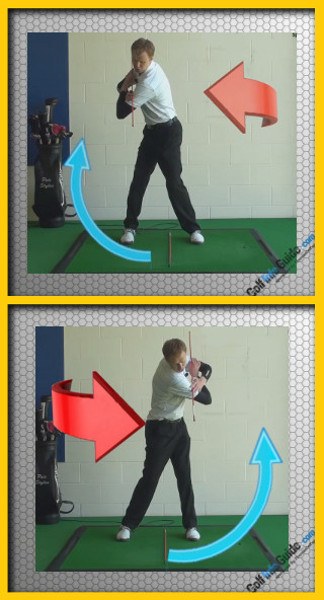Swing in the Right Direction Techniques

After aligning yourself for each shot, and have avoided distractions on the course, it’s time to address the challenge of actually swinging the club on the right path. You need to swing the club to match up with your body alignment, which is a task that it not always as easy as it sounds. Countless amateur golfers use swings which are off track, and as a result, they are unable to hit their selected targets with any kind of consistency.
Without a doubt, the biggest problem in the amateur game with regard to swing path is the over-the-top move which tends to create a slice. When this mistake is made, the player loops the club up and away from the body during the transition from backswing to downswing. Then, since the club is so far away from the body, the only option is to pull it back closer to the body on the way down. In the end, the club sweeps across the ball from outside to inside, and left to right spin will be placed on the ball. This type of shot is very likely to fade, and it may slice if the path is way off track. If you are like so many other amateur golfers, you have dealt with this pattern at least once in your golfing life – and you may still be dealing with it to this day.
Generally speaking, the solution to your swing path problems is going to be found in your lower body. It is usually when your lower body stops doing its job in the swing that your path is going to become a problem – especially when we are talking about an over-the-top swing. During the transition from backswing to downswing, your lower body should begin to rotate toward the target in order to move everything into position. Once your lower body gets started, it should keep turning throughout the downswing and on into the finish. Not only is this move going to help make your swing more powerful, but it is also going to allow you to drop the club into the right position for a great downswing. You should be able to swing slightly from inside-out when you use your lower body properly, meaning your slice should be a thing of the past.
If you think you could improve your swing path through the improved use of your lower body, you can work on this fundamental even when you aren’t at the course. You can make practice ‘swings’ even without a club, and these imaginary swings will help you feel the correct timing for the use of your lower body. To try this quick, club-free drill, please follow the steps below.
The great thing about this drill is the fact that you can use it anything you have a few spare minutes. You don’t need to swing an actual club to improve your technique, and you don’t even have to be at the golf course. By working on the timing of your lower body turn while away from the course, you should notice improved performance when you do head back to the driving range for an actual practice session.






